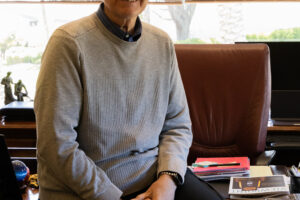San Diego, Calif., and Tijuana, Baja California, Mexico, are two cities that have more in common than just a border. Despite often being portrayed as worlds apart, these twin cities share similar cultures, people groups, foods and even art.
“Estando aquí contigo” or “Being Here with You” is a group exhibition at the Museum of Contemporary Art San Diego that aims to showcase this intricate cross-border relationship through art. It brings together 42 artists from San Diego and Tijuana, including Beliz Iristay, Andrea Chung, Omar Pimienta, Kate Clark and more. These artists address issues surrounding colonialism, feminism, the LGBTQ+ community, climate change, and immigration, using a variety of mediums.
One of the 42 artists featured in the exhibition is Paula Flores, a 29-year-old mixed media visual artist born and raised in Tijuana. Her sculptural installations “Native Flora in the Invaded Landscape” bring together natural and synthetic found and recycled objects to replicate the indigenous flora and fauna that can be found in the San Diego/Tijuana region.
“We are not two separate places, we are one region,” Flores said. “People don’t realize how much we depend on each other and how connected these two communities really are. There’s a lot of creativity on both sides that works together and inspires each other, and a richness that comes from all of the different cultures mixing together, and I find it beautiful.”
The exhibition, open through Feb. 3, borrows its title from the chorus of the song “Angel Baby” by Rosie and The Originals and includes paintings, sculptures, installations, photographs, textiles and short films all vividly depicting social and environmental issues that are affecting both San Diego and Tijuana today.
“I decided to start working with these plants at the small farm that my grandparents have had for as long as I can remember. Some of them I chose for their importance in the environment, for example, the pink sculpture is a blue elderberry tree, which is a keystone species for a lot of animals and native peoples,” Flores said. “Others, I chose for their poetic nature. One of the pieces shows pincushions, which are really long, thin flowers, but they’re very flexible because of the strong winds that they exist in. If they were rigid they would break, but instead they move according to the wind and what comes their way.”
Flores’ abstract pieces examine ideas of geography and territory as well as the effects of climate change on the environment. She explains that her hope is for people to not only start grappling with the idea of human impact on the environment, but that they will also grapple with the art itself, engaging in how each piece fits into the larger experience.
“I am questioning what our relationship is with nature. How can we change our anthropocentric view of it, especially as city dwellers who live in cities that cater to a designed and commodified life style of comfort and consumption of nature?” Flores said.
These are the kinds of ideas and questions that museum-goers will be left to contemplate as they experience the array of perspectives showcased in this exhibition. Perspectives from two cities that, when it comes down to it, couldn’t be more similar.









Add Comment